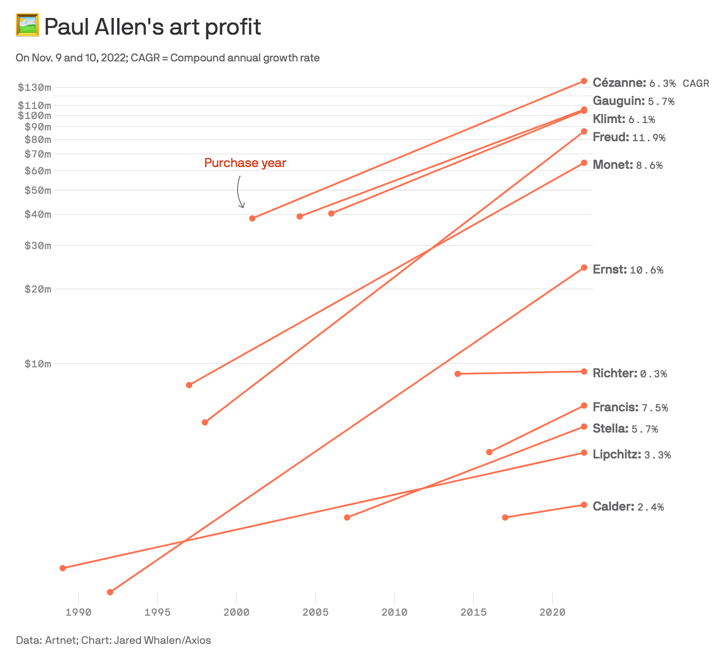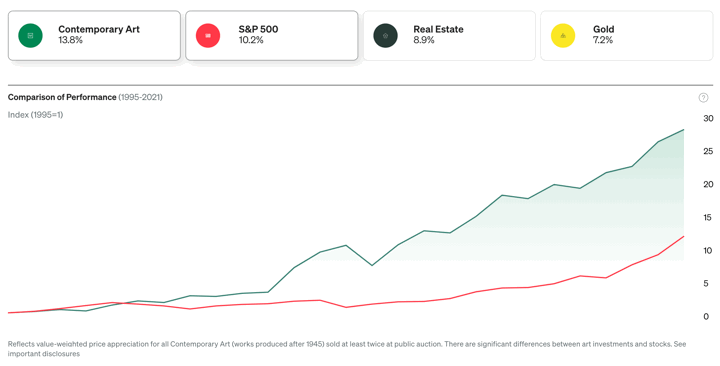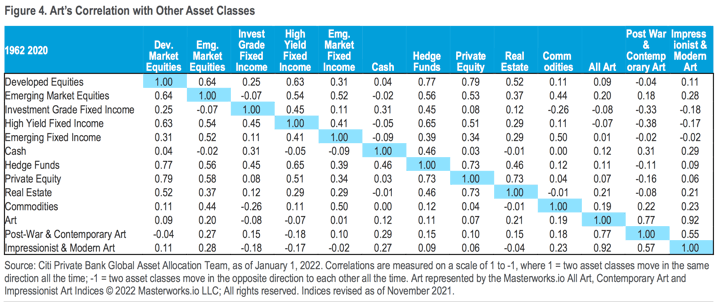
The trend in many alternative asset classes is to make previously illiquid and high-value investments like art, collectibles, farmland, and music royalties more accessible to us common folk by offering fractional ownership. From the comfort of my smartphone, I can buy a $250 fractional share of a Shelby Mustang and hope to sell my equivalent of a turn signal stalk at a tidy profit in the future.
Masterworks does this for art, letting you invest as little as $500 into multi-million dollar works of art by artists like Basquiat, Picasso, and Banksy. The pitch is pretty direct:
Contemporary art has outperformed the S&P for the past 25 years, but there has been no way to invest in it. Masterworks is the first company to offer investment products within the art market.
The Masterworks website claims that the Contemporary Art asset class has returned 13.8% annualized from 1995-2021, much more than the 10.2% from the S&P 500. This data “reflects value-weighted price appreciation for all Contemporary Art (works produced after 1945) sold at least twice at public auction.”

In addition, this chart from a 2022 Citi Art Market report shows that Contemporary Art had a very low or even slightly negative historical correlation with stocks (Developed Equities, -0.04) and bonds (Investment Grade Fixed Income, 0.15).

Here’s what Citi says about future art prices:
Citi Private Bank’s proprietary strategic asset allocation methodology does not address art. We instead approach art primarily from the collector perspective of the clients whom we serve rather than strictly as an investment. In any case, art does not lend itself to an objective cash flow-based analysis as equities, fixed income, and real estate do. In this regard, it has more in common with commodities. As such, rigorous estimates of future long-term returns are not possible.
Alright, how about some more data points then? Recently, the estate of Paul Allen sold off a record-breaking $1.6 billion of art, most of which was also both bought and sold at a public auction. This gives us both the purchase and sell prices and the ability to calculate annualized return. This Axios article included an analysis and created the chart below.

Some sales are impressive, like a Cézanne that was bought for ~$38 million and sold for ~$138 million less than 20 years later. A cool $100 million profit ain’t too shabby. However, once you calculate the overall return including the holding periods, the annualized return was only 6.2% annualized over an average holding period of 18 years. Axios notes that the S&P 500 grew at 8.9% annualized over the past 18 years, which allows them to drop this zinger:
The bottom line: Allen would have made more money just buying an S&P 500 index fund.
I can see art as as an asset class having positive long-term returns in the future, and I can see it having a relatively low correlation to stocks, but I suppose that I have a hard time seeing it return something amazing and consistently better than the S&P 500. Especially for any basket of specific pieces, it may return 4% more than the S&P 500 annually, or it may return 4% less than the S&P 500 annually. This would be more of a fun, amusing thing – “I own a flower petal from that Monet!” – that might retain permanent value in the future.
(I can’t tell a Stella from a Seurat, so I have no personal investment in Masterworks.)
 The Best Credit Card Bonus Offers – 2025
The Best Credit Card Bonus Offers – 2025 Big List of Free Stocks from Brokerage Apps
Big List of Free Stocks from Brokerage Apps Best Interest Rates on Cash - 2025
Best Interest Rates on Cash - 2025 Free Credit Scores x 3 + Free Credit Monitoring
Free Credit Scores x 3 + Free Credit Monitoring Best No Fee 0% APR Balance Transfer Offers
Best No Fee 0% APR Balance Transfer Offers Little-Known Cellular Data Plans That Can Save Big Money
Little-Known Cellular Data Plans That Can Save Big Money How To Haggle Your Cable or Direct TV Bill
How To Haggle Your Cable or Direct TV Bill Big List of Free Consumer Data Reports (Credit, Rent, Work)
Big List of Free Consumer Data Reports (Credit, Rent, Work)
Of course, Paul Allen’s portfolio reflects Paul Allen’s taste and seems heavily weighted toward Moderns rather than market cap weighted for the art market as a whole. Hanging a Cezanne on the wall provides a hedonic return that is not directly comparable to hanging a certificate for U.S. Gypsum. I suspect if Paul Allen would have invested based less on his personal tastes and more on a Harry Markowitz basis he’d likely have done better overall, though with fewer Cezanne-like “home runs.”
The Master Works claim of asset class returns is questionable because it only includes pieces “sold at least twice at public auction”. That does not actually give you enough information to determine if the figure contains foresight bias (and is both massively over-stated and unobtainable) or not. For example, if their dataset contains all pieces that have had at least 2 auction sales since 1945, and they are including the first & second sale of those pieces in the return calculation, it’s like saying if you invested in the current 2022 constituents of the S&P 500 in 2012 you’d have earned some ridiculous large return over the last 10 years (meaning you would have had to exactly predict the S&P 500 constituents of 2022). In such a case, the 13.8% annualized return is massively over-stated and not representative of the asset class. If on the other hand, they only include the 3rd and subsequent returns in their return calculations, then it’s more legitimate.
One must also keep in mind that there are auction sales commissions on both the purchase and sale of any asset. Additionally, as a collectible asset, the IRS gets a flat 28% tax, rather than the normal income or capital gains rates. Both of these costs must be netted against the buy-sell gross gain to get a realistic net return.
Also, I imagine it costs quite a bit of money to insure and take care of such a valuable piece of art.
Love this article. This kind of info on supposedly overperforming asset classes helps me stay the course. This blog has helped me not to buy into the bitcoin craze. Even the ESG rating trend seems kind of fishy to me.
Great info on comments re tax treatment and insurance.
I’ve not seen a similar write-up/argument made on perhaps a more liquid analogue – sports cards. Instead of there being one Monet, you still have 10+ of even the rarest cards out there. There’s a similar market available to average Joes in Collectible.